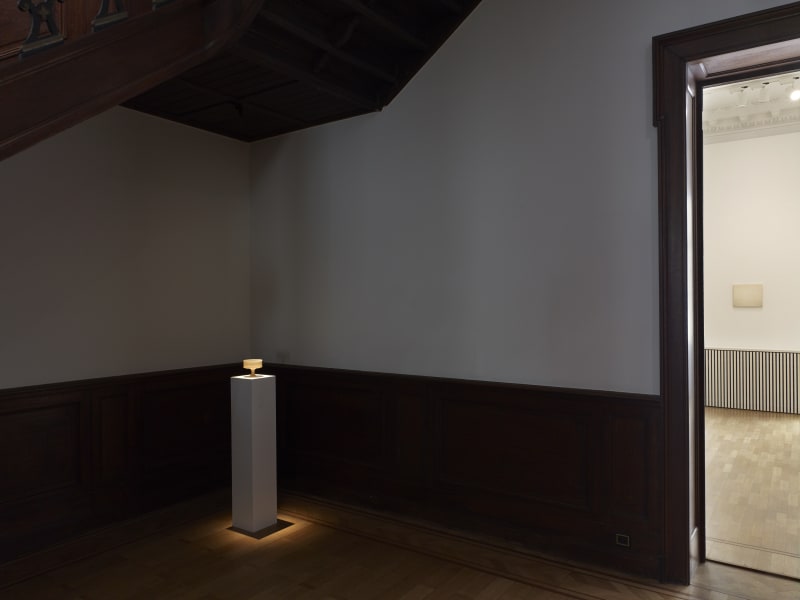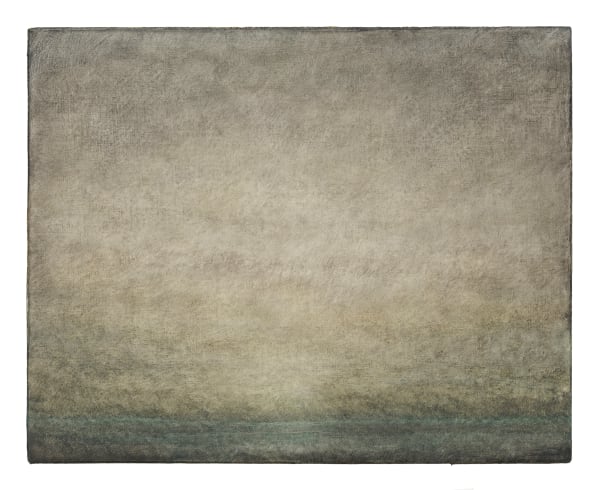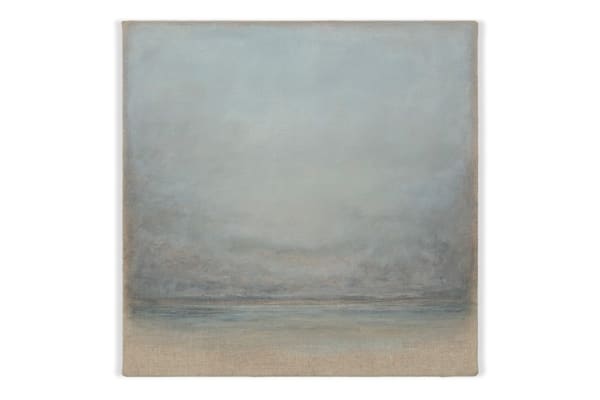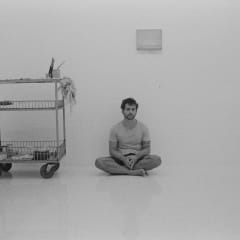Neutral Corner Lucas Arruda
I don’t know if you can hear it.
We are all holding our breath.
The gloves has been taken off him.
There are four men in the corner
Facing him Paret may draw a warning in the moment.
Stretched out in the corner, just above us,
in the neutral corner.
Wonder just how much that fight might have taken out of Paret.
Or maybe, it didn’t taken anything out of him.
Paret usually fights better when hurt, or when he’s back against the rope. The tendency to fight after the bell.
Paret apparently trying to slow down.
Paret is pretty tired himself It’s almost hopeless.
We are gonna stop it as Paret sags to the canvas.
I don’t think he knows where he is.
Paret is against the rope
Paret about to go down
Paret goes down from sheer exhaustion
It’s over now
There is the bell.
The work of few contemporary artists is able to evoke the sublime and have a tranquilizing effect the way Lucas Arruda paintings do. Where so many seem intent upon obstreperously embodying and conveying the infinite noise of the contemporary, his work has a way of all but shutting it out, quieting and centering whoever looks at what he does. It’s as if they were small, portable sound-proof rooms, mute autonomous chambers, that admitted only one person at a time into their perfect, atmospheric calm. How does he do this? What procedure, if any, allows him to generate such tranquility? How do you account for this?
Side-stepping the rabbit-hole of genius, I think two new works in this show can help us if not understand, then at least begin to situate where this takes place. One is a sculptural installation (which features a painting) and the other is a new video which Arruda has been working on, intermittently, for years. Highly complementary, the two works play off one another in an interesting, almost dialectical fashion. The installation consists of placing a series of small objects in front of a seascape horizon painting in an architectural recess. The central element of the installation consists of a small, Etruscan statue whose severe and gaunt verticality is not without recalling the work of Giacometti. Symmetrically flanked by a series of small objects, the Etruscan statue is placed in front of the center of the painting, as if the combination of the horizon depicted therein and the object created a cross. Provisionally conjoined as such, they amount to a geometric ideal which has less to do with religion than an archetypical notion of centering, which is at the heart of a great deal of Arruda’s painting. The slight, uncanny object takes on an even greater significance vis-à-vis the artist’s new video.
This strange, powerful and haunting work is based on the footage of the 1962 Welterweight boxing championship fight between Benny Paret and Emile Griffith in which Paret entered a coma and died ten days later in the hospital. Scrambling the order in which events took place in the video, the montage skips around to the moment in which we see Paret fall from his K.O.. Interestingly, the video begins in perfect silence with the referee and the boxers, and the teams from each boxer standing in the ring facing the same way in a conspicuously parallel fashion straight up, not unlike the Etruscan figure standing obediently in the recess in the other room. While they apparently do not move (since this fight takes place at Madison Square Garden, they are presumably listening to the National Anthem), the surrounding crowd does. Eventually they start to move, boxers bouncing up and down, and the sound track of the video, the mournful and elegiac composition, Strokur (2014) by the Icelandic cellist Hildur Guðnadóttir, kicks in coming in and out over the announcer’s commentary and the din of the surrounding crowd. Guðnadóttir’s doleful soundtrack is paired with imagery which shifts from grainy close ups of legs in the ring to shots of the vibrating ropes themselves which cut across the screen as if it were a minimalist abstraction. Impossible not to see these three lines and think of the multiplicity of horizons that populate, like a single, pathologically repeated motif, the artist’s paintings. It’s at this point that an analogy of thresholds, of the interior and exterior, and even life and death (since it is precisely in the ring that Paret began his passage into that domain from whose bourn no traveller returns) begins to emerge between the paintings and the video. The montage then goes on to alternate between headless, besuited bodies congregating ponderously and the thin, spindly legs of the boxers dancing individually and together in the ring. While the imagery shifts to the faces of the boxers and the upper bodies and the mood of the soundtrack drops to altogether more urgent register, foreshadowing the blow to come, we never actually witness the volley of uppercuts that led to Paret’s demise. But the fall that succeeds them, the one characterized by the announcer as a result of “sheer exhaustion”, this we witness as it becomes clear that it is the real subject of the video. In the initial fall, which the montage repeats a number of times, it’s almost as if Paret’s near lifeless body is aided downward by the strokes of Guonadóttir’s bow against the cello strings. The poignance of this conjunction, which touches upon the sublime, is effectively impossible to describe. It – the poignance – is perhaps matched only by the imagery of the hands and arms which seek to undo Paret’s body from the ropes and lay him down on the ring’s floor. Formally evocative of myriad renaissance portrayals of The Deposition (Christ’s removal from the cross and transfer to the tomb), the moment is interesting for Arruda not only because of this, but also due to its relationship to surrender and care (One almost wants to repeat it, surrender and care, surrender and care, if only for the sake of form). Again, what is of interest here is less the religious evocation than its formal resonance and complexity.
And yet, that is not all. What about the paintings? What about the broken and yet interconnected horizon that connects, separates and encircles these two new works? Where do they stand between the immutable verticality of the Etruscan statue, and Paret’s definitively collapsing figure? Or maybe they are the limitless expanse and the fine threshold that both links and divides these two poles from one another? Or maybe they mirror our experience of looking at them? Where one is reminiscent of the horizontality of the horizon line in the painting, the other mimics our verticality before the image. Rigorously and starkly conjoined, they always place us, the viewer, at the center, and are liable to lead to a strange and incommunicable peace.
– Chris Sharp
-
 Lucas Arruda, Untitled (from the Deserto-Modelo series), 2018
Lucas Arruda, Untitled (from the Deserto-Modelo series), 2018 -
 Lucas Arruda, Untitled (from the Deserto-Modelo series), 2018
Lucas Arruda, Untitled (from the Deserto-Modelo series), 2018 -
 Lucas Arruda, Untitled (from the Deserto-Modelo series), 2018
Lucas Arruda, Untitled (from the Deserto-Modelo series), 2018 -
 Lucas Arruda, Untitled (from the Deserto-Modelo series), 2018
Lucas Arruda, Untitled (from the Deserto-Modelo series), 2018 -
 Lucas Arruda, Untitled (from the Deserto-Modelo series), 2017
Lucas Arruda, Untitled (from the Deserto-Modelo series), 2017 -
 Lucas Arruda, Untitled (from the Deserto-Modelo series), 2018
Lucas Arruda, Untitled (from the Deserto-Modelo series), 2018 -
 Lucas Arruda, Untitled (from the Deserto-Modelo series), 2017
Lucas Arruda, Untitled (from the Deserto-Modelo series), 2017 -
 Lucas Arruda, Untitled (from the Deserto-Modelo series), 2018
Lucas Arruda, Untitled (from the Deserto-Modelo series), 2018 -
 Lucas Arruda, Untitled (from the Deserto-Modelo series), 2017
Lucas Arruda, Untitled (from the Deserto-Modelo series), 2017 -
 Lucas Arruda, Untitled "Neutral Corner", 2018
Lucas Arruda, Untitled "Neutral Corner", 2018












